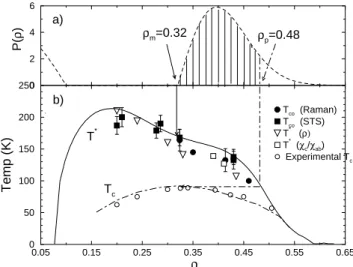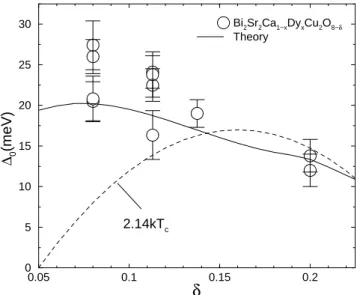A Novel Perolation Theory for High
Temperature Superondutors
E.V.L.de Mello, E.S. Caixeiro, and J.L.Gonzalez
Departamento deFsia,UniversidadeFederalFluminense,
Av. Litor^anias/n,Niteroi,R.J.,24210-340, Brazil
Reeivedon28February,2002
Wepresent aperolationtheoryforthe high-T
oxides pseudogapandT
dependeneonthe hole
level. Thedopingdependentinhomogeneous hargestrutureis modeledbyadistributionwhih
mayrepresentthestripemorphologyandyieldaspatialdistributionofloalT(r). Thetemperature
onsetofspatial dependentsuperondutinggap is identiedwiththevanishingof thepseudogap
temperatureT
. Thetransitiontoasuperondutingstateorrespondstotheperolationthreshold
amongregions of dierent T
. Asaparadigm we use aHubbard Hamiltonianwith amean eld
approximation to yield a doping and temperature dependent superonduting d-wave gap. We
showherethat thisnewapproahreprodues thephasediagram, explainsandgivesnewinsights
onseveralexperimentalfeaturesofhigh-Toxides.
I Introdution
High-T
oxideshasbeendisoveredfteenyearsago[1℄
butmanyoftheirimportantpropertiesremainsnotwell
understood. Amongthese,thepseudogapphenomenon,
that is, a disrete struture of the energy spetrum
aboveT
,identiedbyseveraldierentexperiments[2℄,
hasitsnaturenotyetbeenlaried. Suhopenproblem
hasattratedalotofexperimentalandtheoretialeort
beauseitisgeneralbeliefthatitssolutionisrelatedto
theunderstandingofthesuperondutingfundamental
interation.
The evidene of suh energy gap above the
superonduting phase is learly demonstrated by
tunneling[3, 4℄ and angle-resolved photoemission
spetrosopy[5,6℄experiments. Intheresistivity
mea-surementsitspreseneisseenbyadereaseinthelinear
behaviorbelowT
[7,8℄andinthespeiheatasa
sup-pressioninthelinearoeÆientofthetemperature[9℄.
Thereisalsomountingexperimentalevidenesthat
the hole doped inhomogeneity into the CuO
2
planes,
ommontoalluprates,isdiretlyrelatedtothe
pseu-dogap phenomenon. In a given family, the
under-doped ompounds near the doping onset of
superon-dutivity havethe more inhomogeneousharge
distri-butions and the larger T
. As the doping level
in-reases, thesamples beome morehomogeneouswhile
T
dereases[10, 11, 12℄. For overdoped ompounds
T
disappears or beomes equal to T
. The
inhomo-studies of high temperature superondutors[13℄ but
only after the disover of the spin-harge stripes[14℄,
they havebeome a matter of systemati studies. In
the spin-harge stripes senario, regions of the CuO
2
planesarehole-rih(thestripes)andothersregionsare
hole-poorwhih llthespaebetweenthestripes.
Reently, magneti exitations as the vortex-like
Nernst eet have been reported above T
[15℄ and a
loalMeissnerstate,whihusuallyappearsonlyinthe
superonduting phase, has been seen as a preursor
tosuperondutivity[16℄. Suhinhomogeneous
diamag-neti domains developnear T
and growontinuously
asT dereasestowardsT
. NearT
,thedomainsappear
toperolate,aordingtoFig.3fromIguhietal.[16℄.
Basedonalltheseexperimentalndings,aboutthe
pseudogap phenomenon, loal harge inhomogeneities
andanon perolativeloalMeissner statebetweenT
andT
,weproposeanewsenariotoexplain thehigh
T
superondutorsphenomenology: duetothedoping
dependenthargeinhomogeneitiesinagivenompound
withaveragehargedensity
m
,there isadistribution
ofloal lusterswith spatialdependenthargedensity
(r),eahwithitssuperondutingtransition
tempera-tureT
(r). T
isthelargestofallT
(r). Asthe
temper-ature falls below T
, some lusters beome
superon-duting,buttheyaresurroundedbymetalliand/or
an-tiferromagnetiinsulating domains and, onsequently,
num-ature dereases, so the superonduting regions grow
and, eventually, at a temperature T
, they perolate
and beomeableto hold amarosopi dissipationless
urrent. ExatlyastheMeissner statedomainsshown
inFig.3ofIguhietal.[16℄. Similarideasweredisussed
byOvhinnikovat al[17℄. Theywereonernedmainly
with themirosopi mehanismwhih leadsto a
dis-tributionofT
(r)anditseetonthedensityofstate.
Inorderto showthat these ideasareableto make
quantitativepreditionsandreproduethehigh-T
ox-idesphasediagram,wehaveperformedalulationson
aHubbardmodelandagapequationisobtainedwithin
meaneldapproahtoderiveT
. Afterwards,using
theperolation approah, weshowthat wean
repro-duealsotheexperimentalvaluesfortheBi2212T
.
II The Charge Distribution
The presene of mirosopi harge inhomogeneities
distribution in the CuO
2
planes in a striped
ongu-rationiswelldoumented[14℄. Italsoimpliesinstrong
modiationsfortheloalstrutureastheloalCu O
bondlengthhangesitssizewiththeaverageloal
dop-inglevel[10,11,18℄.
The onsequene of these intrinsi mirosopi
harge inhomogeneities distribution in the CuO
2
planes, is theexistene oftwophases whih are
spon-taneously reated in the CuO
2
planes; regions whih
arehole-rihformthestripesandothersregionswhih
are hole-poor(the antiferromagneti insulatorregion)
and are reated between the harge-rih stripes (the
metalli region). Theexatlyformofthese harge
dis-tributions is not known and it is presently matter of
researh[10,11,18℄butweandrawsomeinsightsfrom
the STM/S results of Pan et al.[12℄. Based on these
STM/Sdata,wehavehosenaombinationofa
Pois-sonandaGaussiandistribution. Foragivenompound
with an average harge density
m
, the hole
distribu-tionP isafuntionoftheloalholedensity,P(;
m ).
It isdivided in twobranhes: Thelowdensity branh
representstheinsulatingregions, andthehigh density
one represents the metalli regions. As onerns the
superondutivity, only theproperties of thehole rih
branh are important sine the urrent ows through
themetalliregion. Suhdistributionmaybegivenby:
P() = (
)exp( (
)
2
=2(
)
2
)=
( 2
)(2 exp( (0:10) 2
=2(
)
2
)) (1)
The plus sign is for the hole-rih (
m ) for
m
,theminusto thehole-poorbranh(
=0:10)
for 0:10 and P() = 0 for 0:10 .
FromtheexperimentalSTM/SGaussianhistogram
dis-tribution for the loal gap[12℄ in an optimally doped
Bi
2 Sr
2 CaCu
2 O
8+x (
m
0:32)(seeFig.2dofRef.12),
we get that the half-width for the metalli branh is
abouthalfofthemeandopingvalue,thatis2
+
=0:16,
sinetheloalgapisproportionaltotheloalhole
den-sity. Furthermore
+
is relatedwith the degreeof
in-homogeneities, and weestimate the
+
values for the
other ompounds usingthe fat thatit dereaseswith
theholedensity.
ThedistributionP()for
m
=0:32and
+ =0:08
is shownin Fig.1a.. As a generalfeature for a family
ofompounds,basedalsointheexperimentalresultsof
Pan et al.[12 ℄, for samples with
m
0:5, theharge
distributionbeomesasimpleGaussianenteredat
m
with 0:04,whih reets thenon-existene of the
stripesphasesforoverdopedsamples.
Thevalues of for agivensample are hosen in
order that perolation in the hole-rih branh ours
exatlyatagivendensity
p
. ThusT
(
p
)isthe
maxi-mumtemperaturewhihthesystemanperolateand
whihweidentifyasequaltoT
(
m
). Aordingtothe
perolationtheory,the thresholdofperolationours
in asquarelattie when59%of thesitesorbondsare
lled[19℄. Thus, we nd the density where the
hole-rih branh perolates integrating R
P()d from
m
till the integral reahes the value of 0.59, where we
dene
p
. Below T
(
m
) the superonduting region
perolatesand, onsequently,it isableto holda
dissi-pationless superurrent. To estimate T
(
m
) weneed
to alulateT
asfuntionof.
III The Phase Diagram
To develop the dynamis of the hole-type arriers in
theCuO
2
planes, weadopt atwodimensionextended
HubbardHamiltonian inasquarelattieof lattie
pa-rametera
H =
X
ij t
ij
y
i
j +U
X
i n
i" n
i#
+ X
<ij> 0
V
ij
y
i
y
j 0
j 0
i
(2)
wheret
ij
isthehoppingintegralbetweensitesiandj;
U istheCoulombon-siteorrelatedrepulsionandV
ij is
theaphenomenologialattrativeinteration between
nearest-neighborsites.
UsingaBCS-typemean-eld approximationto
de-velop Eq.(2) in the momentum spae, one obtains
tempera-tures[20,21,22℄ k = X k 0 V kk 0 k 0 2E k 0 tanh E k 0 2k B T ; (3) with E k = p " 2 k + 2 k
; whih ontains the potential
V
kk
0. Forad-waveorder parameter,U issummedout
of the gap equation and the amplitude of the
attra-tive potential V is the only unknown variable whih
beomes anadjustable parameter[22, 23℄. "
k
is a
dis-persion relation. The hole density and the gap
equa-tion, are solved self-onsistently for a d-wave order
parameter[22,23℄.
InFig.1bweplotthetemperaturesofvanishinggap
T
asfuntion of, derivedwith theaboveequations.
Here weuseV = 0:150eVwhihreprodueswell the
experimentalvaluesofT
fortheBi2212system[7℄.
Thehoppingparametersarewithin15%tothosetaken
from ARPESmeasurements[24℄with anearest
neigh-borhopping t
ij
=0:12eV(t
ij
=0:147eVinref.24)and
further hopping parametersupto fth neighbor. The
partiular form oftheT
urvedepends onthevalues
ofthese hoppings. Notiethatthedensityofholeshas
afatorof2withrespettothevaluesgivenbyRef.[7℄,
butinagreementwithref.[21℄asitismoreappropriate
fortheBi2212system[25℄.
0.05
0.15
0.25
0.35
0.45
0.55
0.65
ρ
0
50
100
150
200
250
Temp (K)
T
co
(Raman)
T
co
(STS)
T
*
(
ρ)
T
*
(
χ
c
/
χ
ab
)
Experimental T
c
0
2
4
6
P(
ρ
)
ρ
m
=0.32
ρ
p
=0.48
a)
b)
T
*
T
c
Figure 1. 1a)The probability distributionfor theoptimal
ompoundwithm=0:32. 1b)Thealulatedonsetof
van-ishing gap T
(). The thik arrow shows T
(m) andthe
dot-dasharrowshowshowT
(
m
)isfound. The
experimen-talpointsandthesymbolsaretakingfromRef.[7 ℄
The T m and T m
diagrams are obtained
as follows: A ompound with an average holeontent
higherthanthe onsetofsuperondutivityforBi2212,
that is,
m
0:15, has its metalli branh with
lo-al densities(r)varyingfrom
m
tohighervalues. In
this range, T
is a dereasing funtion of .
There-fore for temperatures above T
(
m
), there is neither
any gap nor any superonduting region and T
( )
marks the appearane of a gap in the sample. That
iswhy T
(
m
) is theT
of thesystem. On the other
hand,T
(
m
)is alulatingintegrating R
P()dfrom
m
till theintegralreahesthevalueof0.59(the
inte-gratedregion is markedwith vertial lines in Fig.1a),
where we dene
p
. Only at T T
(
p
) (see Fig.1a
for
p
= 0:48) the ompound may hold a
superon-dutingurrentsinethesuperondutingregions
per-olatesthroughthesample. ThusT
(
p
)isthe
pero-lating threshold and it is equalto T
(
m
) as onean
seefollowingthedot-dashedlinein Fig.1aand1b).
Itisworthwhiletomentionthattheperolating
ap-proah ouldalsobeused withothersmethods to
al-ulatingT
m
,like,forinstane,theonewhihuses
theHubbard-Holstein Hamiltonian[27℄.
IV Disussion
Thefat that T
dereases ontinuouslywith in the
superonduting region(
m
>0:15),asseeninFig.1b,
isverysuggestiveanditisin agreementwiththeearly
ideasregardingaphononmediatedsuperonduting
in-terations: Materials whose vibrating atoms interat
stronglywiththeeletrons,andarepoormetals,should
beome superondutors at higher temperatures than
those good metals, whose atoms interat weakly with
eletrons[26℄. For uprates, asthe doping level of the
samplesinreases,itiswellknownthattheompounds
hange from verypoormetals in thenormal phase to
verygoodmetalswithtypialFermiliquidbehaviorfor
overdopedsamples. SineT
m
isadereasing
fun-tionofdopingforanyupratefamilybeyondtheonset
ofsuperondutivity,suhbehaviormaybeastrong
in-diationofthephononisuperondutinginteration.
There are several observations and measurements
that an be well explained within the perolating
ap-proah,wewill disusshereonlyafewexamples.
1-Harriset al.[28℄, throughARPES measurements,
havereportedtheanomalousbehaviorof
0 (
m )whih
dereasessteadily with thedoping
m
although T
in-reases by a fator of 2 for their underdoped
sam-ples. Inthe overdopedregion, sineT
also dereases,
thebehavior is theexpeted onventional
proportion-ality. It is well known that superondutors have a
onstant valuefor the ratio 2
0 =k
B T
, being3.75 for
usual isotropi order parameter and 4.18 for d
x 2
y 2
solution[29℄.
Atlowtemperature, sinethe superonduting
re-gionperolates throughdierent regions, eah with a
given
0
(r),tunnelingandARPESexperimentsdetet
thelargestgappresentintheompound. Consequently,
0 (
m
)mustbeorrelatedwiththeonsetofvanishing
gapT
(
m
)whih isthelargestsuperonduting
tem-perature in the sample, and not with T
(
m
). As we
show in Fig.2, orrelating the values for T
(
m ) with
ofHarriset al.[28℄on Dy BSCCO andexplainsthe
dierentenergysalespointedoutbyHarrisetal. and
severalothersauthors.
0.05
0.1
0.15
0.2
δ
0
5
10
15
20
25
30
∆
0
(meV)
Bi
2
Sr
2
Ca
1−x
Dy
x
Cu
2
O
8−
δ
Theory
2.14kT
c
Figure2. Thezerotemperaturegap for9samplesas
mea-suredbyHarrisetal[28℄andouralulations.
2- The resistivity for underdoped and optimum
dopedompoundsdeviatesatT
fromthelinear
behav-iorand falls faster asthe temperature[2, 7℄ dereases.
This behavior an be understood by our model, with
theinreasingofsuperondutingluster numbersand
size, as the temperatures dereases below T
. Eah
superondutinglusterproduesashortiruitwhih
dereases the resistivitybelow thelinear behavior
be-tweenT
andT
.
3-Asmentioned in theintrodution, the existene
ofsuperondutinglusterbetweenT
andT
easily
ex-plainstheappearaneofloal diamagnetiorMeissner
domains,and,ifthereisatemperaturegradientinthe
sample, theloalux owsand produesthedynami
ux owstate[15℄.
4-Anotherimportantonsequeneisthat the
pair-ing mehanism must be investigated by experiments
performed mainly at T
. A suh experiment was
a-omplished byRubio Tempranoet al.[30℄, whih
mea-sured a large isotope eet assoiated with T
and
an almost negligible isotopi eet assoiated with T
in the slightly underdoped HoBa
2 Cu
4 O
8
ompound.
The results strongly support the fat that
eletron-phononinduedeetsarepresentinthe
superondut-ingmehanismassoiatedwithT
.
V Conlusions
We have demonstrated that the perolating approah
foraninhomogeneoushargedistributionontheCuO
2
planesprovidesnewphysialexplanationsformany
ex-perimentsperformedonhigh-T
oxidesandquantitative
Contrarytosomeurrenttrends,inwhihT
is
re-garded as aphase oherene temperature and the
ex-istene of a gap phase without oherene between T
and T
, in our approah, T
is a perolating
temper-ature for dierent regions whih, due to the
inhomo-geneities, possessdierentloal superonduting
tran-sition T
(r). Similarly, insteadof having a
superon-duting gap
s
and an exitation gap assoiated
with T
, we have a distribution of loally dependent
s (r).
Theperolationmethodintroduedhereanbe
ap-plied inanyuprateandyields alsoseveralnew
impli-ations whih will be disussed elsewhere, but one of
themostinterestingis thatoneansearh for
materi-alswith verylargeT
'sif abetter ontrol of theloal
dopinglevelisahieved.
Finanial support of CNPq and FAPERJ is
grate-fully aknowledged. JLG thanks CLAF for a
CLAF/CNPqpos-dotoralfellowship.
Referenes
[1℄ J.G.BednorzandK.A.Muller,Z.Phys.64,189(1986).
[2℄ T. Timusk and B. Statt, Rep. Prog. Phys. 62, 61
(1999).
[3℄ C.Renner,B.Revaz,J.-YGenoud,K.Kadowaki,and
O.Fisher,Phys.Rev.Lett.80,149(1998).
[4℄ M.Suzuki,T.Watanabe,andA.Matsuda,Phys.Rev.
Lett.82,5365 (1999).
[5℄ Z-X.ShenandD.S.Dassau,Phys.Rep.253,1(1995).
[6℄ H.Ding,T.Yokkoya,J.C. Campuzano,T.Takahashi,
M.Randeria,M.RNorman,T.Mohiku,K.Kadowaki,
andJ.Giapintzaki,Nature,382,511996
[7℄ M. Oda, N. Momono, and M. Ido, Superond. Si.
Tehnol.13,R139,(2000).
[8℄ H.Takagi, B.Batlogg,H.L.Kao,R.J.Cava,J.J.
Kra-jewski, and W.F. Pek, Phys. Rev. Lett. 62, 2975
(1992).
[9℄ J. Loram, K.A.Mirza, J.R. Cooper, and J.L. Tallon,
PhysiaC282-287, 1405(1997).
[10℄ S.J.L.Billinge,E.S.Bozin,M.Gutmann,andH.
Tak-agi, J. Superond., 2306 (2000), Proeedings of the
Conf. \Major Trends in Superondutivity in New
Milenium",andond-mat0005032.
[11℄ E.S.Bozin,G.H.Kwei,H.Takagi,andS.J.L.Billinge,
Phys.Rev.Lett.84,5856, (2000).
[12℄ S.H. Pan, J.P. ONeal, R.L. Badzey, C. Chamon, H.
Ding,J.R.Engelbreht,Z.Wang.H.Eisaki,S.Uhida,
A.K. Gupta, K.W. Ng, W.W. Hudson, K.M. Lang,
and J.C. Davis, Nature 413, 282 (2001) and
ond-mat/0107347.
[13℄ T.Egamiand S.J.L.Billinge, in\Physial Properties
of High-Temperatures Superondutors V" edited by
[14℄ J.M.Traquada,B.J.Sternlieb,J.D.Axe,Y.Nakamura,
andS.Uhida,Nature(London),375,561(1995).
[15℄ Z.A. Xu, N.P. Ong, Y. Wang, T. Kakeshita, and S.
Uhida,Nature406,486(2000).
[16℄ I.Iguhi,I.Yamaguhi,andA.Sugimoto,Nature,412,
420(2001).
[17℄ Yu.N.Ovhinnikov,S.A.Wolf,andV.Z.Krezin,Phys.
Rev.B63, 6452, (2001), andPhysiaC341-348, 103,
(2000).
[18℄ T.Egami, Pro.oftheNew3SCInternational
Confer-ene,tobepublishedinPhysiaC.
[19℄ D.F. Stauer and A.Aharony,Introdution to
Pero-lation Theory,Taylor&FranisEd.,London,1994.
[20℄ E.V.L.deMello,PhysiaC259,109(1996).
[21℄ G.G.N.Angilella,R.Pui,andF.Siringo,Phys.Rev.
B54,15471(1996).
[22℄ E.S. Caixeiro, and E.V.L. de Mello, Physia C 353,
103(2001).
[23℄ E.S.Caixeiro,andE.V.L.deMello,submittedtothe
J.Phys.CM.
[24℄ M.R.Norman,M.Randeria,H.Ding,J.C.Campuzano,
andA.FBellman,Phys.Rev.B52,615(1995).
[25℄ P.Konsin,N.Kristoel, andB.Sorkin,J.Phys.C.M.
10,6533(1998).
[26℄ B.T.Matthias,Superondutivity,SientiAmerian,
92,Novemberof1957.
[27℄ C. Di Castro, M. Grilli, and S. Caprara,
ond-mat/0109319.
[28℄ J.M. Harris, Z.H. Shen, P.J. White, D.S. Marshall,
M.C.Shabel,J.N.Ekstein,andI.Bozovi,Phys.Rev.
B54,R15665(1996).
[29℄ H.WonandK.Maki,Phys.Rev.B49,1397(1994).
[30℄ D.RubioTemprano,J.Mesot,S.Janssen,K.Conder,
A.Furrer,H.Mutka,andK.A.Muller,Phys.Rev.Lett.
84,1990(2000).
[31℄ M.T.D. Orlando, A.G Cunha, E.V.L. de Mello, H.
Belih, E. Baggio-Saitovih, A. Sin, X. Obradors, T.
Burghardt, and A. Eihler, Phys. Rev. B61, 15454
(2000).
[32℄ J.L.Gonzalez,M.T.D.Orlando,E.S.Yugue,E.V.L.de
Mello,andE.Baggio-Saitovih,Phys.Rev.B63,54516

